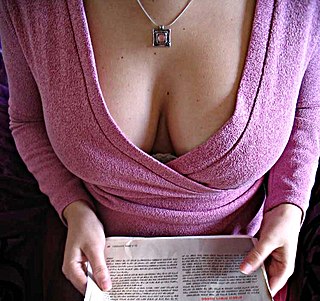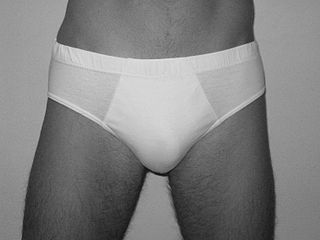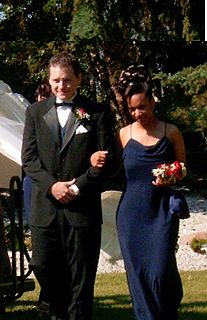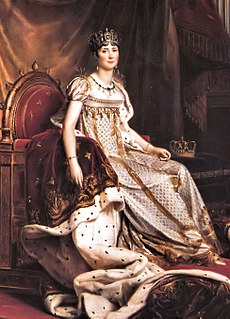 W
WAn aglet or aiglet is a small sheath, often made of plastic or metal, used on each end of a shoelace, a cord, or a drawstring. An aglet keeps the fibers of the lace or cord from unraveling; its firmness and narrow profile make it easier to hold and easier to feed through eyelets, lugs, or other lacing guides.
 W
WIn modern clothing and fashion design, a button is a small fastener, now most commonly made of plastic but also may be made of metal, wood, or seashell, that joins two pieces of fabric together. In archaeology, a button can be a significant artifact. In the applied arts and in craft, a button can be an example of folk art, studio craft, or even a miniature work of art.
 W
WCleavage is the narrow depression or hollow between human breasts. The superior portion of cleavage may be accentuated by clothing such as a low-cut neckline that exposes the division. Joseph Breen, head of the U.S. film industry's Production Code Administration, coined the term in its current meaning when evaluating the 1943 film The Outlaw, starring Jane Russell. The term was explained in Time magazine on August 5, 1946. It is most commonly used in the parlance of Western female fashion to refer to necklines that reveal or emphasize décolletage.
 W
WMost jackets have a variety of inner pockets, and two main outer pockets, which are generally either patch pockets, flap pockets, or jetted pockets.
 W
WA collar stay, collar stick, collar tab, collar stiffener, or collar stiff is a shirt accessory consisting of a smooth strip of rigid material, rounded at one end and pointed at the other, inserted into specially made pockets on the underside of a shirt collar to stabilize the collar's points. The stays ensure that the collar lies flat against the collarbone, looking crisp and remaining in the correct place.
 W
WIn humans, the crotch is the bottom of the pelvis, the region of the body where the legs join the torso, and is often considered to include the groin and genitals.
 W
WDarts are folds and sewn into fabric to take in ease and provide shape to a garment, especially for a woman's bust. They are used frequently in all sorts of clothing to tailor the garment to the wearer's shape, or to make an innovative shape in the garment. Fabric may be thought of as flat, and a dart has the effect of removing a wedge shaped piece and pulling the edges of that wedge together to create a shallow cone. This effect can be seen quite easily with a paper pattern by pulling together the edges of a dart intake as it would be sewn. Since fabric is generally more flexible than paper the fabric will shift around the apex of the cone and form a softer, but still curved, shape. In a garment a dart ends in a point at a full area of the body.
 W
WIn sewing and tailoring, facing is a small piece of fabric, separate or a part of the fabric itself, used to finish the fabric edges. Facing makes a garment look professionally finished with the seams well hidden inside the folds of the facing. Facing is mostly used to finish the edges in necklines, armholes, hems and openings. They are also used widely in all other sewing like quilts and home decor items like curtain hems.
 W
WIn sewing and dressmaking, a ruffle, frill, or furbelow is a strip of fabric, lace or ribbon tightly gathered or pleated on one edge and applied to a garment, bedding, or other textile as a form of trimming.
 W
WFringe is an ornamental textile trim applied to an edge of a textile item, such as drapery, a flag, or epaulettes.
 W
WGeodeulji is a small piece of white cloth to attach to the edge of sleeves of hanbok, traditional Korean attire. Its inner is back up by changhoji (창호지), a type of Korean paper and its width is about 6 ~ 8 cm. Geodeulji is attached to dangui or jangot to cover hands because showing hands in front of seniors was considered not a courtesy during the Korean Joseon Dynasty.
 W
WIn sewing, a gusset is a triangular or rhomboidal piece of fabric inserted into a seam to add breadth or reduce stress from tight-fitting clothing. Gussets were used at the shoulders, underarms, and hems of traditional shirts and chemises made of rectangular lengths of linen to shape the garments to the body.
 W
WThe hemline is the line formed by the lower edge of a garment, such as a skirt, dress or coat, measured from the floor.
 W
WLapels are the folded flaps of cloth on the front of a jacket or coat and are most commonly found on formal clothing and suit jackets. Usually they are formed by folding over the front edges of the jacket or coat and sewing them to the collar, an extra piece of fabric around the back of the neck.
 W
WLeading strings are strings or straps by which to support a child learning to walk. In 17th and 18th century Europe, they were narrow straps of fabric attached to children's clothing which originally functioned as a sort of leash to keep the child from straying too far or falling as they learned to walk.
 W
WA liripipe is an element of clothing, the tail of a hood or cloak, or a long-tailed hood. The modern-day liripipe appears on the hoods of academic dress.
 W
WA placket is an opening in the upper part of trousers or skirts, or at the neck or sleeve of a garment. Plackets are almost always used to allow clothing to be put on or removed easily, but are sometimes used purely as a design element. Modern plackets often contain fabric facings or attached bands to surround and reinforce fasteners such as buttons, snaps, or zippers.
 W
WA pleat is a type of fold formed by doubling fabric back upon itself and securing it in place. It is commonly used in clothing and upholstery to gather a wide piece of fabric to a narrower circumference.
 W
WA pocket is a bag- or envelope-like receptacle either fastened to or inserted in an article of clothing to hold small items. Pockets are also attached to luggage, backpacks, and similar items. In older usage, a pocket was a separate small bag or pouch.
 W
WA pom-pom – also spelled pom-pon, pompom or pompon – is a decorative ball or tuft of fibrous material.
 W
WPrincess seams are long rounded seams sewn into women's blouses or shirts to add shaping or a tailored fit to closely follow a woman's shape. They are sewn into the front and/or back of a shirt, and extend from the waist up to the arms. Princess seams are distinct from darts in that they form a continuous line and are a full seam. Darts, on the other hand, are folds sewn into the clothing to shape the resultant garment. The main difference from viennese seams is that princess seams run down from the shoulder, whereas viennese seams run down from the armhole.
 W
WIn sewing and dressmaking, a ruffle, frill, or furbelow is a strip of fabric, lace or ribbon tightly gathered or pleated on one edge and applied to a garment, bedding, or other textile as a form of trimming.
 W
WA spaghetti strap is a very thin shoulder strap used to support clothing, while providing minimal shoulder straps over otherwise bare shoulders. It is commonly used in garments such as swimwear, camisoles, crop tops, brassieres, sundresses, cocktail dresses, and evening gowns, so-named for its resemblance to the thin pasta strings called spaghetti.
 W
WA strap, sometimes also called strop, is an elongated flap or ribbon, usually of leather or other flexible materials.
 W
WTrim or trimming in clothing and home decorating is applied ornament, such as gimp, passementerie, ribbon, Ruffle (sewing)s, or, as a verb, to apply such ornament.
 W
WViennese seams are long, rounded seams, used in figure-hugging or tailored fit outerwear. They begin in the middle of the armscye and lead in an arc over the chest to the waist or hem of the garment. The main difference from princess seams is that princess seams run down from the shoulder, whereas viennese seams run down from the armhole.
 W
WThe waistline is the line of demarcation between the upper and lower portions of a garment, which notionally corresponds to the natural waist but may vary with fashion from just below the bust to below the hips. The waistline of a garment is often used to accentuate different features. The waistline is also important as a boundary at which shaping darts can be ended.
 W
WA yoke is a shaped pattern piece which forms part of a garment, usually fitting around the neck and shoulders, or around the hips to provide support for looser parts of the garment, such as a gathered skirt or the body of a shirt. Yoke construction was first seen in the 19th century. Bodice yokes were first seen in the 1880s, whilst the yoke skirt, a skirt suspended from a fitted hip yoke, was first seen in 1898.